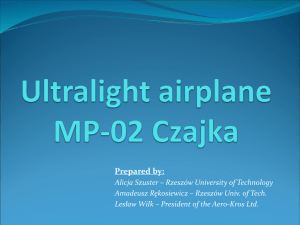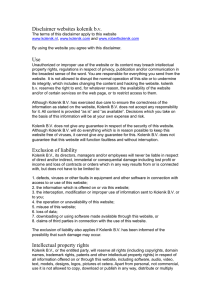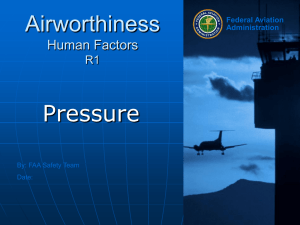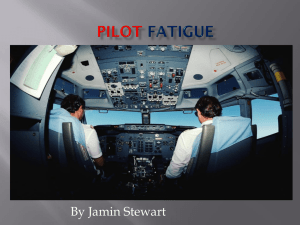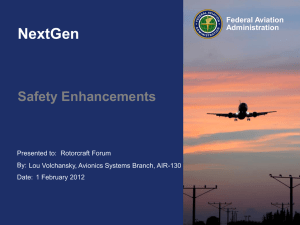HF ATC/TO RE&D Program Development
advertisement
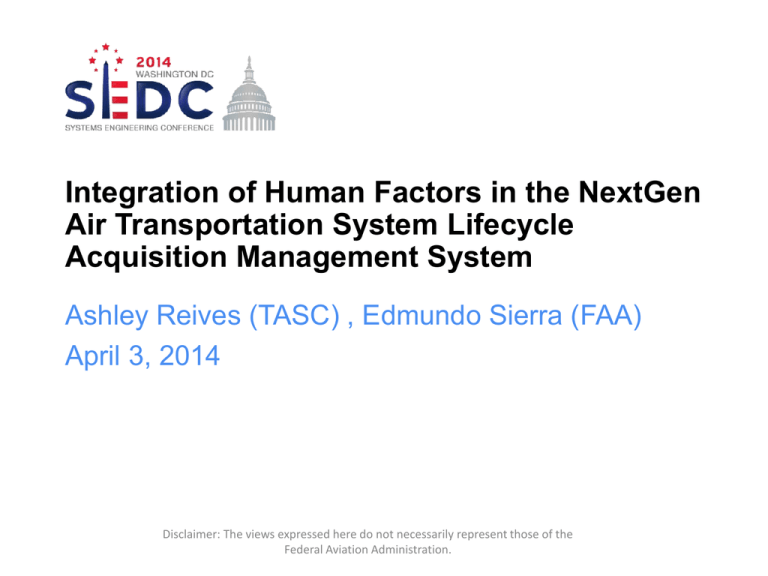
Integration of Human Factors in the NextGen Air Transportation System Lifecycle Acquisition Management System Ashley Reives (TASC) , Edmundo Sierra (FAA) April 3, 2014 Disclaimer: The views expressed here do not necessarily represent those of the Federal Aviation Administration. Federal Aviation Administration and NextGen • The FAA’s implementation of the Next Generation Air Transportation System (NexGen) is a crucial component of the increased capacity and efficiency the National Airspace (NAS) • The Implementation of NextGen requires the applications of many programs and technologies from diverse engineering disciplines and specialties • These NextGen “enablers” aid NextGen in meeting its strategic capabilities Disclaimer: The views expressed here do not necessarily represent those of the Federal Aviation Administration. What is NextGen? • • • NextGen encompasses the ongoing transformations within the NAS and the evolution to a satellite-based system of air traffic management The current air traffic management technology has been in use since the World War II era, and does not optimize the allocation of resources and airspace Incorporates the implementation of technologies, procedures and standards with the goals of: • • • Increasing the safety of the NAS Decreasing delays and fuel usage Efficiently directing air traffic More information on NextGen can be found at: http://www.faa.gov/nextgen/ Disclaimer: The views expressed here do not necessarily represent those of the Federal Aviation Administration. The NAS as a Systems of Systems • The NAS is a diverse and complex system and incorporates the applications of many programs and technologies • The diversity of the components in the NAS requires a multi disciplinary approach to realize success • The FAA utilizes systems engineering principles to execute projects that have been identified as essential to the advancement of the NAS in order to effectively assess the complexity of the project’s lifecycle Disclaimer: The views expressed here do not necessarily represent those of the Federal Aviation Administration. The Acquisition Management System in the FAA Disclaimer: The views expressed here do not necessarily represent those of the Federal Aviation Administration. HF Integration and the Human Factors Acquisition Working Group (HFAWG) • Human Factors is… • • • The scientific discipline concerned with the understanding of interactions among humans and other elements of a system, and the profession that applies theory, principles, data, and other methods to design in order to optimize human well-being and overall system performance. (Human Factors and Ergonomics Society, HFES) In the FAA, the Human Factors Research and Engineering Division (ANG-C1) is delegated to manage, direct, and coordinate the agency’s human factors research and engineering program ANG-C1 authorized the formation of the Human Factors Acquisition Working Group (HFAWG) to promote the utilization of human factors principles and resources • The HFAWG is a cross-organizational body of HF stakeholders who support the practical application of human factors in the AMS Disclaimer: The views expressed here do not necessarily represent those of the Federal Aviation Administration. The Issue and Research Need • • • Human Factors practitioners in the FAA—including members of the HFAWG—often convey the difficulties in increasing and enforcing program utilization of HF guidance and policy in the AMS lifecycle Programs often are unaware of the support available, and commonly do not seek HF practitioner input until late in the AMS lifecycle The HFAWG seeks to directly interface with programs to promote HF usage and identify areas for improved HF input in the AMS lifecycle Disclaimer: The views expressed here do not necessarily represent those of the Federal Aviation Administration. Methods • HFAWG kick-off meeting held in September 2013 • • Participants—all HF Subject Matter Experts(SMEs) were provided with an overview of the role of human factors in lifecycle acquisition management and decision points The overview was followed by an analysis session to identify where changes to acquisition management policy, guidance, processes, procedures, or tools will improve the delivery of human factors services or provide new services of value to the FAA • The session and survey were used to assess SME judgment on HF usage within the AMS and stimulate discussion Disclaimer: The views expressed here do not necessarily represent those of the Federal Aviation Administration. Survey Structure • • • • • Questions 1-2 Participant background Questions 3-4 Effectiveness of the program-level overview Questions 5-6 Resources to provide to external sources for a similar overview Questions 7-8 Ranking questions on HF guidance available by phase of the AMS lifecycle Questions 9-12 Open ended questions focused on the usage of HF guidance by individual programs in the FAA Disclaimer: The views expressed here do not necessarily represent those of the Federal Aviation Administration. 9 Q1: What Phase of the FAA Lifecycle Management Process are you most familiar with? 8 7 6 5 4 3 2 1 0 Service Analysis & Strategic Planning Concept & Requirements Definition Initial Investment Analysis Final Investment Analysis Solution Implementation In-Service Management Disclaimer: The views expressed here do not necessarily represent those of the Federal Aviation Administration. Q7: Which Lifecycle Phases currently have the greatest level of HF guidance and input for the completion of the FAA documents covered? (Rank 1-6) Service Analysis & Strategic Planning Greatest Available Guidance (1) Concept & Requirements Definition 2 Initial Investment Analysis 3 Final Investment Analysis 4 Solution Implementation In-Service Management Disclaimer: The views expressed here do not necessarily represent those of the Federal Aviation Administration. 5 Least Available Guidance (6) Q8: Which Lifecycle Phase could benefit from additional HF guidance and input? (Rank 1-6) Service Analysis & Strategic Planning Concept & Requirements Definition Initial Investment Analysis Greatest Benefit (1) 2 3 Final Investment Analysis 4 Solution Implementation 5 In-Service Management Least Benefit (6) Disclaimer: The views expressed here do not necessarily represent those of the Federal Aviation Administration. Q10: What do you believe is the current usage and impact of HF guidance documents? Which have you seen being utilized for the completion of program documentation? HFDS and Investment Analysis Documents are utilized Minimal to no usage As templates and examples Currently used as a last minute review to meet ISR Checklist Contractors perform the majority of HF AMS work 0 1 2 3 4 Disclaimer: The views expressed here do not necessarily represent those of the Federal Aviation Administration. 5 6 7 Q12: As a whole, how do you feel we can increase the level of accessibility and visibility of HF guidance documents and material for program requirements? Lifecycle documentation of HF in the AMS Enforce HF activities (inc. Training for PMs) Creation of visible HF checklist Update, streamline, and clarify the key documents (which ones apply) Increase HF support across organizations Create a repository HF documents Provide points-of-contact for guidance Train the HF and non-HF workforce 0 1 2 3 Disclaimer: The views expressed here do not necessarily represent those of the Federal Aviation Administration. 4 5 Discussion • Many Programs do not know guidance is available or where to seek guidance • The HFAWG is seeking to interface with programs early in the acquisition lifecycle and streamline documentation of resources • Increasing the accessibility of HF guidance and ease of usage will improve the usage by program managers and document owners • Available guidance is not representative of all stages in the acquisition lifecycle • The HFAWG and HF community is looking to identify areas where increased HF will provide the greatest benefits to program development • In some phases, the greatest benefit may not be received by developing guidance for phases with the least existing documentation Disclaimer: The views expressed here do not necessarily represent those of the Federal Aviation Administration. Summary • • • The integration of HF in NextGen will require a comprehensive systems approach to integrating available research and guidance materials The HFAWG continues to provide a forum for the technical exchange and development of HF solutions and guidance for implementation in the AMS lifecycle. The HFAWG is interfacing with stakeholders at the program and policy levels to identify HF needs Program management and HF Specialists must collaborate to develop beneficial materials and support programs throughout all phases of the AMS lifecycle Disclaimer: The views expressed here do not necessarily represent those of the Federal Aviation Administration. Questions? 17



